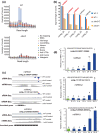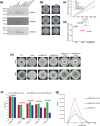Trichoderma atroviride hyphal regeneration and conidiation depend on cell-signaling processes regulated by a microRNA-like RNA
- PMID: 36239595
- PMCID: PMC9676055
- DOI: 10.1099/mgen.0.000869
Trichoderma atroviride hyphal regeneration and conidiation depend on cell-signaling processes regulated by a microRNA-like RNA
Abstract
The ability to respond to injury is essential for the survival of an organism and involves analogous mechanisms in animals and plants. Such mechanisms integrate coordinated genetic and metabolic reprogramming events requiring regulation by small RNAs for adequate healing of the wounded area. We have previously reported that the response to injury of the filamentous fungus Trichoderma atroviride involves molecular mechanisms closely resembling those of plants and animals that lead to the formation of new hyphae (regeneration) and the development of asexual reproduction structures (conidiophores). However, the involvement of microRNAs in this process has not been investigated in fungi. In this work, we explore the participation of microRNA-like RNAs (milRNAs) molecules by sequencing messenger and small RNAs during the injury response of the WT strain and RNAi mutants. We found that Dcr2 appears to play an important role in hyphal regeneration and is required to produce the majority of sRNAs in T. atroviride. We also determined that the three main milRNAs produced via Dcr2 are induced during the damage-triggered developmental process. Importantly, elimination of a single milRNA phenocopied the main defects observed in the dcr2 mutant. Our results demonstrate the essential role of milRNAs in hyphal regeneration and asexual development by post-transcriptionally regulating cellular signalling processes involving phosphorylation events. These observations allow us to conclude that fungi, like plants and animals, in response to damage activate fine-tuning regulatory mechanisms.
Keywords: RNA-seq; RNAi machinery; conidiation; filamentous fungi; hyphal regeneration; milRNAs; signaling; small RNAs; transcriptome.
Conflict of interest statement
The authors declare that they have no conflicts of interests.
Figures






Similar articles
-
Argonaute and Dicer are essential for communication between Trichoderma atroviride and fungal hosts during mycoparasitism.Microbiol Spectr. 2024 Apr 2;12(4):e0316523. doi: 10.1128/spectrum.03165-23. Epub 2024 Mar 5. Microbiol Spectr. 2024. PMID: 38441469 Free PMC article.
-
Transboundary milRNAs: Indispensable molecules in the process of Trichoderma breve T069 mycoparasitism of Botrytis cinerea.Pestic Biochem Physiol. 2023 Nov;196:105599. doi: 10.1016/j.pestbp.2023.105599. Epub 2023 Aug 29. Pestic Biochem Physiol. 2023. PMID: 37945247
-
Identification of microRNA-Like RNAs in the filamentous fungus Trichoderma reesei by solexa sequencing.PLoS One. 2013 Oct 2;8(10):e76288. doi: 10.1371/journal.pone.0076288. eCollection 2013. PLoS One. 2013. PMID: 24098464 Free PMC article.
-
The interaction of fungi with the environment orchestrated by RNAi.Mycologia. 2016 May-Jun;108(3):556-71. doi: 10.3852/15-246. Epub 2016 Mar 1. Mycologia. 2016. PMID: 26932186 Review.
-
Apical control of conidiation in Aspergillus nidulans.Curr Genet. 2016 May;62(2):371-7. doi: 10.1007/s00294-015-0556-0. Epub 2016 Jan 18. Curr Genet. 2016. PMID: 26782172 Review.
Cited by
-
Argonaute and Dicer are essential for communication between Trichoderma atroviride and fungal hosts during mycoparasitism.Microbiol Spectr. 2024 Apr 2;12(4):e0316523. doi: 10.1128/spectrum.03165-23. Epub 2024 Mar 5. Microbiol Spectr. 2024. PMID: 38441469 Free PMC article.
-
Modes-of-action of antifungal compounds: Stressors and (target-site-specific) toxins, toxicants, or toxin-stressors.Microb Biotechnol. 2023 Jul;16(7):1438-1455. doi: 10.1111/1751-7915.14242. Epub 2023 May 16. Microb Biotechnol. 2023. PMID: 37191200 Free PMC article. Review.
-
Global discovery, expression pattern, and regulatory role of miRNA-like RNAs in Ascosphaera apis infecting the Asian honeybee larvae.Front Microbiol. 2025 Mar 4;16:1551625. doi: 10.3389/fmicb.2025.1551625. eCollection 2025. Front Microbiol. 2025. PMID: 40104596 Free PMC article.
-
The IV International Symposium on Fungal Stress and the XIII International Fungal Biology Conference.Fungal Biol. 2023 Jul-Aug;127(7-8):1157-1179. doi: 10.1016/j.funbio.2023.04.006. Epub 2023 May 11. Fungal Biol. 2023. PMID: 37495306 Free PMC article.
References
Publication types
MeSH terms
Substances
Supplementary concepts
LinkOut - more resources
Full Text Sources
Molecular Biology Databases

